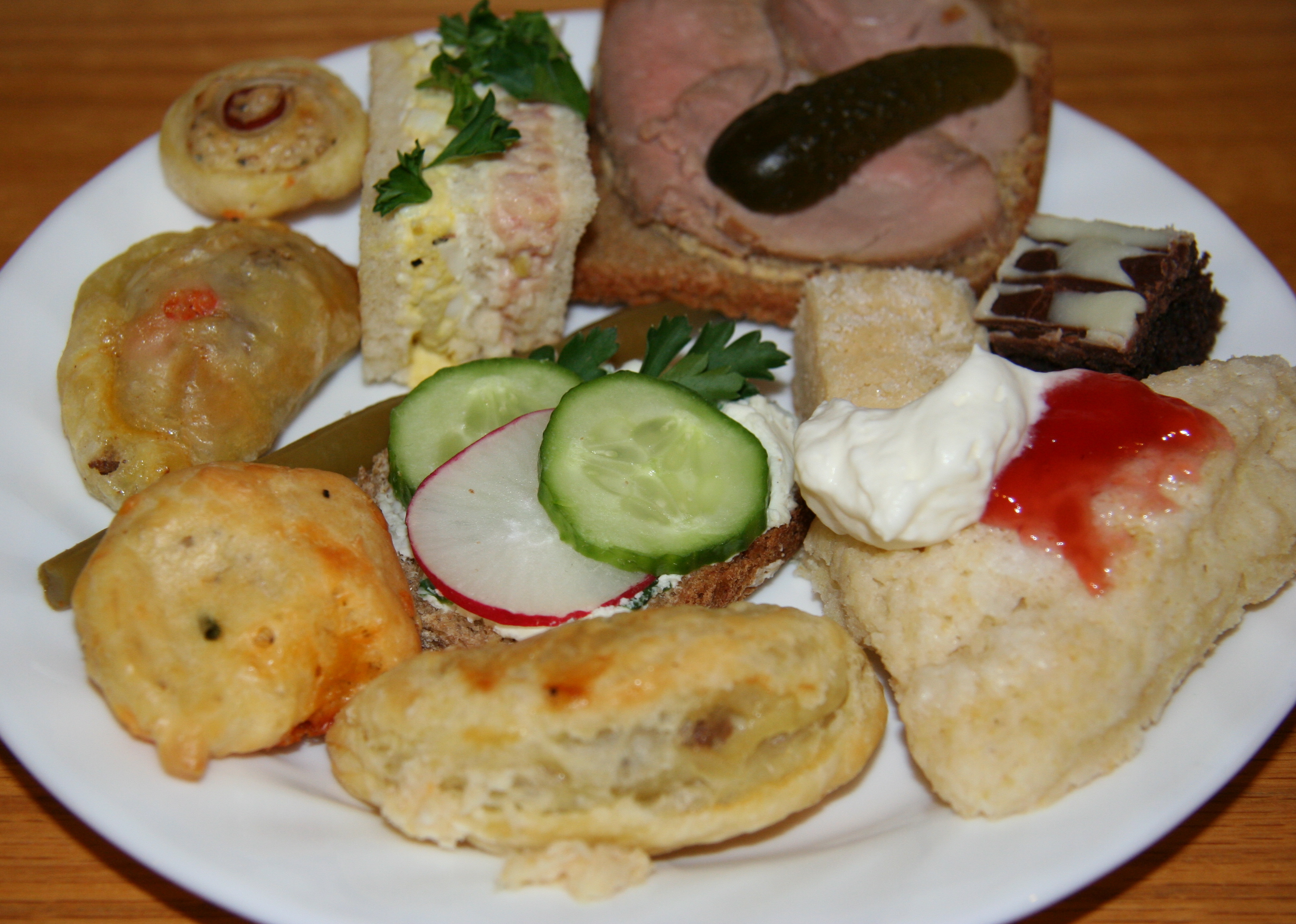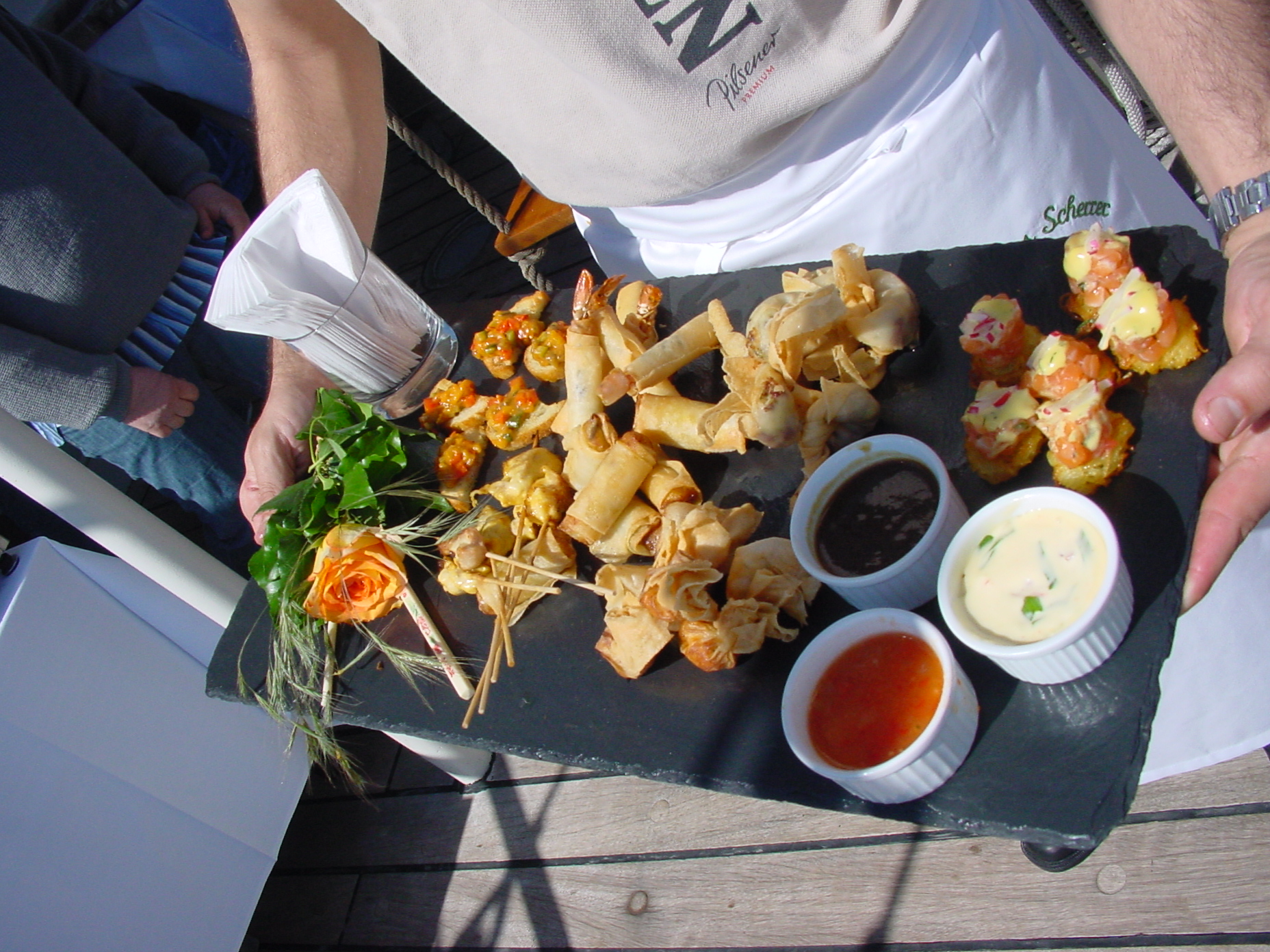Fingerfood on:
[Wikipedia]
[Google]
[Amazon]

 Finger foods are small, individual portions of
Finger foods are small, individual portions of
 Drinks before dinner became a custom towards the end of the 19th century. As this new fashion caught on, the British took inspiration from the French to begin serving hors d'oeuvres before dinner. A
Drinks before dinner became a custom towards the end of the 19th century. As this new fashion caught on, the British took inspiration from the French to begin serving hors d'oeuvres before dinner. A
 Most
Most
 Finger foods are small, individual portions of
Finger foods are small, individual portions of food
Food is any substance consumed by an organism for nutritional support. Food is usually of plant, animal, or fungal origin, and contains essential nutrients, such as carbohydrates, fats, proteins, vitamins, or minerals. The substance is inge ...
that are eaten out of hand. They are often served at social events. The ideal finger food usually does not create any mess (i.e. no crumbs, drips, or any kind of mess), but this criterion is often overlooked in order to include foods like tacos. One origin for finger foods is the French canapé.
History of finger foods
Finger foods do not share common origin, history, or identity. Most of them originate inhors d'oeuvre
An hors d'oeuvre ( ; french: hors-d'œuvre ), appetiser or starter is a small dish served before a meal in European cuisine. Some hors d'oeuvres are served cold, others hot. Hors d'oeuvres may be served at the dinner table as a part of the m ...
like canapé. During the Middle Ages formal French meals were served with entremets
An entremet or entremets (; ; from Old French, literally meaning "between servings") in French cuisine historically referred to small dishes served between courses but in modern times more commonly refers to a type of dessert. By the end of the ...
between the serving of plates. These secondary dishes could be either actual food dishes, or elaborate displays and even dramatic or musical presentations. In the 14th century, recipes for entremets were mostly made with meat, fish, pork and vegetables. By the 15th century the elaborate display and performances were served up between courses, and could be edible or displays of subjects relevant to the host, created in butter sculpture or other types of crafted work. With the introduction in the 17th century of '' service à la française'', where all the dishes are laid out at once in very rigid symmetrical fashion, entremets began to change in meaning but were still mainly savoury. Along with this came elaborate silver and ceramic table displays as well as pièces montées. The entremets were placed between the other dishes within the main work of the meal. One kind of finger food is the French canapé, known since the late 1700s. Canapés began as slices of toasted or fried bread with various toppings. Their name, literally 'sofa', was inspired from how the toppings "sat" on the bread as though it were a sofa. Over time, canapés became a word to describe all finger foods served at parties.
 Drinks before dinner became a custom towards the end of the 19th century. As this new fashion caught on, the British took inspiration from the French to begin serving hors d'oeuvres before dinner. A
Drinks before dinner became a custom towards the end of the 19th century. As this new fashion caught on, the British took inspiration from the French to begin serving hors d'oeuvres before dinner. A cocktail party
A cocktail party is a party at which cocktails are served. It is sometimes called a cocktail reception. A cocktail party organized for purposes of social or business networking is called a mixer.
A cocktail hour is sometimes used by manag ...
is considered a small gathering with mixed drinks and light snacks. Hors d'oeuvres may be served as the only food offering at cocktail parties and receptions, where no dinner is served afterward. After the end of prohibition in the United States, the cocktail party gained acceptance. Prior to the First World War, American dinner guests would be expected to enter the dining room immediately where drinks would be served at the table with appetisers. This changed by the 1920s, when hors d'oeuvres were served prior to a non-alcoholic cocktail; however, after the repeal of Prohibition in the United States, cocktail parties became popular with many different hors d'oeuvres meant as something to help counter the stronger drinks. It is the cocktail party that helped transfer the hors d'oeuvres from the formal dining table to the mobility of the serving tray. These appetisers passed around the cocktail party may also be referred to as canapés.
Finger foods and prohibition
Canapés were often served in speakeasies duringAmerican Prohibition
In the United States from 1920 to 1933, a nationwide constitutional law prohibited the production, importation, transportation, and sale of alcoholic beverages. The alcohol industry was curtailed by a succession of state legislatures, and ...
. Following the enactment of American Prohibition laws in 1920, many people drank in secret, often in speakeasies. To ensure that guests did not appear intoxicated after leaving to avoid detection, speakeasies often served finger foods throughout the night. These finger foods also allowed guests to eat while drinking because of the food's small size.
After Prohibition, canapés were often served at cocktail parties.
Modern finger foods
There is a wide variety of finger foods. Contemporary finger foods are often served asfast food
Fast food is a type of mass-produced food designed for commercial resale, with a strong priority placed on speed of service. It is a commercial term, limited to food sold in a restaurant or store with frozen, preheated or precooked ingredien ...
as well as at formal events.
Fast food
 Most
Most fast food
Fast food is a type of mass-produced food designed for commercial resale, with a strong priority placed on speed of service. It is a commercial term, limited to food sold in a restaurant or store with frozen, preheated or precooked ingredien ...
is finger food. Finger food is quick to eat, and can be eaten on the go. For producers, the simple recipes of finger foods allows them to create new menu options that share ingredients.
Parties and events
Finger foods are often served at formal events and celebrations in the form of passedhors d'oeuvre
An hors d'oeuvre ( ; french: hors-d'œuvre ), appetiser or starter is a small dish served before a meal in European cuisine. Some hors d'oeuvres are served cold, others hot. Hors d'oeuvres may be served at the dinner table as a part of the m ...
, where they create a casual, relaxed atmosphere and keep guests' hands and fingers entertained.
References
Further reading
* ''The McDonaldization of Society'' (SAGE Publications, Inc.), George Ritzer {{DEFAULTSORT:Finger Food Eating behaviors of humans Street food